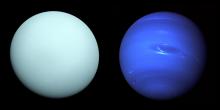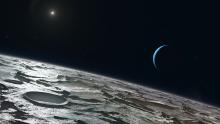Listen to today's episode of StarDate on the web the same day it airs in high-quality streaming audio without any extra ads or announcements. Choose a $8 one-month pass, or listen every day for a year for just $30.
You are here
Mars and Neptune
The edge of the realm of the planets is marked by Neptune, the Sun’s fourth-largest major planet. It’s almost four times Earth’s diameter. But you need strong binoculars or a telescope to pick it out. For the next few mornings, though, it’s a little easier to spot than average. That’s because it’s passing close to bright Mars.
Neptune looks so faint because it’s remote — an average of 2.8 billion miles from both Earth and the Sun. At that range, the Sun is just one-tenth of one percent as bright as it appears from Earth. That means there’s not much sunlight to illuminate the planet. And despite its size, Neptune is a tiny target in our skies.
Neptune is only slightly less reflective than the other giant planets — Jupiter, Saturn, and Uranus. Methane in its upper atmosphere absorbs red light, giving the planet a rich blue color. The methane also hides much of the detail in Neptune’s clouds.
Neptune is one of four planets bunched fairly close together in the dawn sky right now. They line up in the east and southeast. Venus, the “morning star,” is lowest in the sky. Bright Jupiter is to its upper right, with Mars a little farther along the same line. It looks like a bright orange star. Neptune will stand a couple of degrees to the left of Mars tomorrow — the width of your finger held at arm’s length. It’ll pass just half a degree above Mars on Wednesday. The gap will widen after that, leaving Neptune all alone.
Script by Damond Benningfield





